Last Prince of Orkney
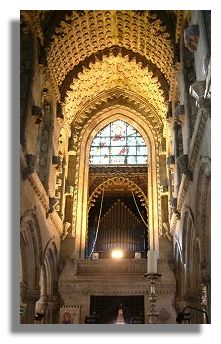 Located on the outskirts of the village of Roslin in Midlothian, a few miles south of Edinburgh, the chapel was founded in 1446 by Sir William St Clair. His name is derived from Saint-Clair-sur-Elle in Normandy. William de Sancto Claro, whose father had come over with William the Conqueror in 1066, came to Scotland with his wife. There were, however, other members of the St. Clair family who came north also. They became established near Edinburgh and were granted the barony of Rosslyn. Sir William de St Clair's heir, Henry St Clair, Earl of Roslin, is reputed to have reached North America 100 years before Columbus, While some writers dispute this, see Did He or Didn't He?
Located on the outskirts of the village of Roslin in Midlothian, a few miles south of Edinburgh, the chapel was founded in 1446 by Sir William St Clair. His name is derived from Saint-Clair-sur-Elle in Normandy. William de Sancto Claro, whose father had come over with William the Conqueror in 1066, came to Scotland with his wife. There were, however, other members of the St. Clair family who came north also. They became established near Edinburgh and were granted the barony of Rosslyn. Sir William de St Clair's heir, Henry St Clair, Earl of Roslin, is reputed to have reached North America 100 years before Columbus, While some writers dispute this, see Did He or Didn't He?
Henry supported Robert the Bruce and fought at the Battle of Bannockburn. The king granted him lands in the Pentlands, south of Edinburgh. Sir Henry died in Spain with Sir James Douglas as they took the heart of Robert the Bruce on a crusade.
Henry de St Clair's son surrendered the Orkney earldom (and the title of Prince of Orkney) and was created Earl of Caithness in 1445 by King James II. It was around this time that the spelling "Sinclair" came into use, usually pronounced in Scotland as "Sinkler".
The chapel took 40 years to build and was originally planned to be part of an even larger building. Sir William drew the design of the chapel and the ornate carvings on timber boards which the masons then copied. It is the amazingly intricate carvings, both inside and out, which make Rosslyn so unique. They have been compared to delicate lace and icing on a cake. The magnificent barrel roof is made up of carved stones (patterns of daisies, stars and roses etc) Throughout the chapel, all the columns and tombs are intricately carved. One carving looks like North American corn and is said to confirm that Sir William crossed the Atlantic.
Knights Templar
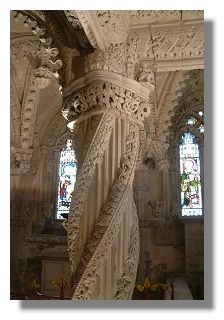 Rosslyn Chapel has long been associated with the Knights Templar, an ancient order going back to the days of the Crusades. In the 12th century the grand master of the order was married to Katherine St Clair and two of the grand masters in the 13th and 14th centuries were members of the St Clair family. When the order was persecuted by the Pope in the early 14th century, some of the Knights escaped to Scotland (where Robert the Bruce had been excommunicated and did not proscribe the order). A number of the carvings at Rosslyn have Templar or Masonic connections and a sealed vault in the Chapel is said to contain religious relics. Over the years, many fanciful theories have been suggested about what might be in the sealed vaults - ranging from the Holy Grail to the Ark of the Covenanant, even the "true" Stone of Destiny. A book, which was written in 1774 for the Masons, gives a detailed account of a secret entrance to the tombs and claims that they contain the remains of ten of the Barons of Rosslyn and some of their armour.
Rosslyn Chapel has long been associated with the Knights Templar, an ancient order going back to the days of the Crusades. In the 12th century the grand master of the order was married to Katherine St Clair and two of the grand masters in the 13th and 14th centuries were members of the St Clair family. When the order was persecuted by the Pope in the early 14th century, some of the Knights escaped to Scotland (where Robert the Bruce had been excommunicated and did not proscribe the order). A number of the carvings at Rosslyn have Templar or Masonic connections and a sealed vault in the Chapel is said to contain religious relics. Over the years, many fanciful theories have been suggested about what might be in the sealed vaults - ranging from the Holy Grail to the Ark of the Covenanant, even the "true" Stone of Destiny. A book, which was written in 1774 for the Masons, gives a detailed account of a secret entrance to the tombs and claims that they contain the remains of ten of the Barons of Rosslyn and some of their armour. 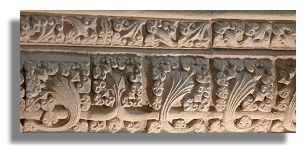
Reformation and After
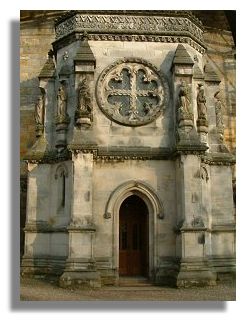
After the Reformation in the 16th century the considerable carvings and embellishments were regarded as "idolatrous" and the monks who looked after it were forced to resign aschurch buildings and land were taken (often violently) into secular hands. The chapel ceased to be a place of worship.
Renovation work in the 1950s appears to have done more harm than good and in 1997 a steel structure was erected round the chapel to allow remedial work to be done and that is still in place. It is probably worth while for visitors to study the guide book on sale before going round the chapel, otherwise you may miss some interesting carvings - I speak from experience!
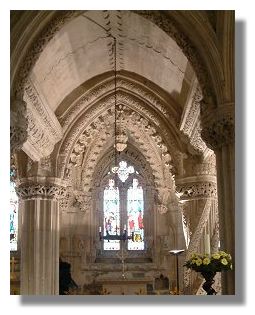
Rosslyn Castle and Roslin Glen Country Park
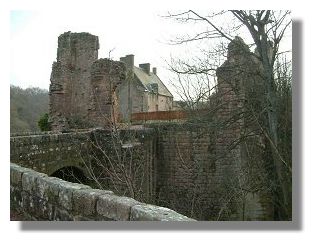
After visiting the chapel, follow the sign to nearby Rosslyn Castle on foot. Access is by appointment only but the approach over a bridge with the river far below is worth a picture in anyone's album. There are also some interesting walks in Roslin Glen Country Park, accessed by some steep steps. You can bring a picnic lunch to eat by the North Esk at a table just down the path and across the bridge from the castle causeway.
Rosslyn Castle began as a 14th century round keep which was extended in the 15th and 16th centuries. The castle was the stronghold of the St Clair (Sinclair) Earls of Orkney and Caithness. The castle was ransacked and set ablaze by the Earl of Hertford in 1544 and again by Cromwell's army in 1650. Part of the building has been made habitable again and can be rented via the Landmark Trust.
How to Find Rosslyn
Confusingly, Rosslyn Chapel is located in a village called Roslin, which is only six miles south of the centtre of Edinburgh, on the A703 road to Penicuik (and eventually Peebles). If you are coming from Edinburgh, watch out for the signs pointing to an access road on the left going through the village. There's a bus service from downtown Edinburgh (Lothian 15A, First 62), with the stop at the foot of Chapel Loan just before the bus turns right off Roslin's Main Street.
For a detailed location map, see the StreetMap UK map of the area. (Note that you can access a larger scale map of the area via that Web page).
There is a richly illustrated, official Rosslyn Chapel Web site which has further information on access, including opening hours.



